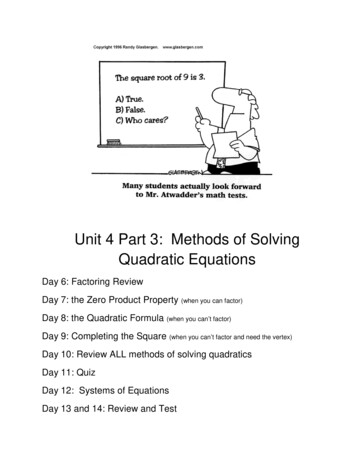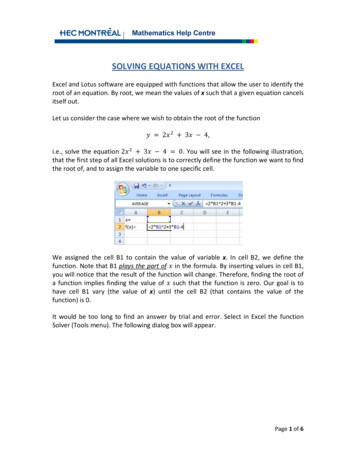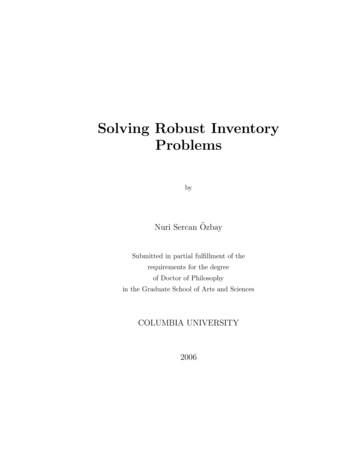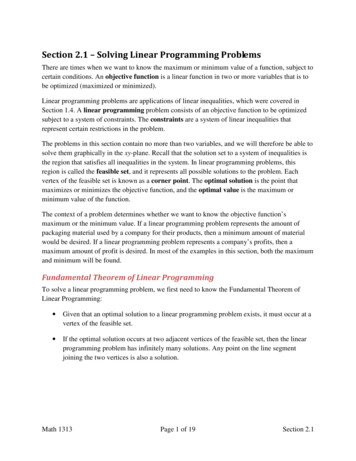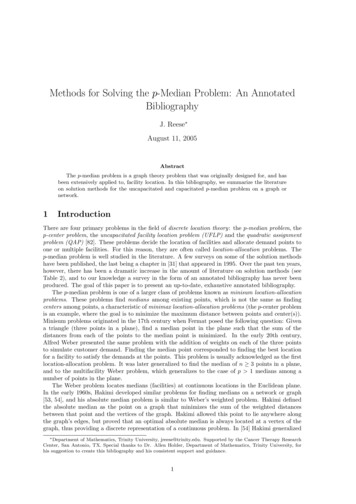
Transcription
Methods for Solving the p-Median Problem: An AnnotatedBibliographyJ. Reese August 11, 2005AbstractThe p-median problem is a graph theory problem that was originally designed for, and hasbeen extensively applied to, facility location. In this bibliography, we summarize the literatureon solution methods for the uncapacitated and capacitated p-median problem on a graph ornetwork.1IntroductionThere are four primary problems in the field of discrete location theory: the p-median problem, thep-center problem, the uncapacitated facility location problem (UFLP) and the quadratic assignmentproblem (QAP) [82]. These problems decide the location of facilities and allocate demand points toone or multiple facilities. For this reason, they are often called location-allocation problems. Thep-median problem is well studied in the literature. A few surveys on some of the solution methodshave been published, the last being a chapter in [31] that appeared in 1995. Over the past ten years,however, there has been a dramatic increase in the amount of literature on solution methods (seeTable 2), and to our knowledge a survey in the form of an annotated bibliography has never beenproduced. The goal of this paper is to present an up-to-date, exhaustive annotated bibliography.The p-median problem is one of a larger class of problems known as minisum location-allocationproblems. These problems find medians among existing points, which is not the same as findingcenters among points, a characteristic of minimax location-allocation problems (the p-center problemis an example, where the goal is to minimize the maximum distance between points and center(s)).Minisum problems originated in the 17th century when Fermat posed the following question: Givena triangle (three points in a plane), find a median point in the plane such that the sum of thedistances from each of the points to the median point is minimized. In the early 20th century,Alfred Weber presented the same problem with the addition of weights on each of the three pointsto simulate customer demand. Finding the median point corresponded to finding the best locationfor a facility to satisfy the demands at the points. This problem is usually acknowledged as the firstlocation-allocation problem. It was later generalized to find the median of n 3 points in a plane,and to the multifacility Weber problem, which generalizes to the case of p 1 medians among anumber of points in the plane.The Weber problem locates medians (facilities) at continuous locations in the Euclidean plane.In the early 1960s, Hakimi developed similar problems for finding medians on a network or graph[53, 54], and his absolute median problem is similar to Weber’s weighted problem. Hakimi definedthe absolute median as the point on a graph that minimizes the sum of the weighted distancesbetween that point and the vertices of the graph. Hakimi allowed this point to lie anywhere alongthe graph’s edges, but proved that an optimal absolute median is always located at a vertex of thegraph, thus providing a discrete representation of a continuous problem. In [54] Hakimi generalized Department of Mathematics, Trinity University, jreese@trinity.edu. Supported by the Cancer Therapy ResearchCenter, San Antonio, TX. Special thanks to Dr. Allen Holder, Department of Mathematics, Trinity University, forhis suggestion to create this bibliography and his consistent support and guidance.1
the absolute median to find p medians on a graph in order to minimize the sum of the weighteddistances. Again, these points were allowed to be located anywhere along the edges of the graph.Although not all optimal solutions to this problem are located at the vertices, Hakimi showed thatthere is always a collection of p vertices that minimizes the objective. Thus, Hakimi again provideda discrete representation of a continuous problem by restricting the search to the vertices. Solutionsconsisting of p vertices are called p-medians of the graph. Thus, the p-median problem differs fromthe Weber problem because it is discrete, a consequence of only being allowed to select mediansfrom the candidate set V . It is also defined on a graph or a network, not a plane.Hakimi developed the absolute median and p-median to find the optimal location of switchingcenter(s) in a communication network. Since his work, the p-median problem has been inseparablefrom location theory, becoming one of the most common facility location models. Another commonmodel is the UFLP, often referred to as the simple plant location problem or the warehouse locationproblem. The UFLP is similar to the p-median problem, and the methods used to solve one areoften adapted to solve the other. Both problems have similar goals. As in the p-median problem,the UFLP involves locating facilities to minimize demand-weighted distance. The problems differin the following ways. First, UFLP involves a fixed cost for locating a facility at a given vertex ornode, and the p-median problem does not. Second, unlike the p-median problem, UFLP does nothave a constraint on the maximum number of facilities. Lastly, typical UFLP formulations separatethe set of possible facilities from the set of demand points. In the p-median problem these sets areidentical. The QAP is also used to model location-allocation, but it is theoretically harder to solvethan the p-median problem. Besides the fact that the objectives differ, the QAP uses flow and costinformation not used in the p-median problem. The p-median problem is driven by distance alone.2The p-Median ProblemThe p-median problem is simply stated as: Given a graph or a network G (V, E), find Vp Vsuch that Vp p, where p may either be variable or fixed (see Section 2.3), and that the sum ofthe shortest distances from the vertices in {V \Vp } to their nearest vertex in Vp is minimized. In thissection we provide an extended problem definition and a unified notation scheme.2.1Basic Problem DefinitionLet G (V, E) be a complete, weighted and undirected graph, where V is the set of vertices andE is the set of edges. Associate with each edge a weight d(vi , vj ), which is the shortest distancebetween vertices vi and vj according to the metric d. The n n symmetric matrix dij [d(vi , vj )]is the shortest distance matrix. Each vertex vi is assigned a weight wi , and the weighted distancematrix isWij wi dij .This matrix is not generally symmetric, unless wi wj for each i and j. The metric p-medianproblem is a variation that restricts the weighted distance to be a metric. The p-median problem isoften defined on a network and in this case a graph may be created by connecting nodes with anedge whose weight is the shortest distance between the nodes on the network.Hakimi [53] defined a point m as an absolute median of G if, for every point vj on G,nXwi d(vi , m) i 1nXwi d(vi , vj ).i 1He later generalized this concept to the well-known p-median definition of today. Let Vp be a set ofp points on G and let d(vi , Vp ) and d(vi , Vp ) be the shortest distances from vertex vi to its nearestelement in Vp and Vp , respectively. The definition from [54] is: A set of points Vp is a p-median ofG if, for every Vp on G,nnXXwi d(vi , Vp ) wi d(vi , Vp ).i 1i 12
Under this generalization, the absolute median is the 1-median of the graph. The term p-medianrefers to the set of vertices Vp . The vertices in Vp are called p-median vertices.A p-median naturally partitions a graph because for each p-median vertex mj , there is a setof vertices that are nearer to that vertex than any other p-median vertex. The nearest neighborpartition cells Pj , for 1 j p, are:Pj {vi : d(vi , mj ) d(vi , mk ), i 1, 2 . . . , 1 k p}.If d(vi , mj ) d(vi , mk ), the vertex vi is usually assigned to the p-median vertex with the smallerindex. The total weighted distance isD n XXwj d(vi , vj ).i 1 vj Pj2.2Integer Programming FormulationThe p-median problem is typically formulated as an integer program (IP) [94]. Let ξij be an allocationvariable such that 1 if vertex xj is allocated to vertex xiξij 0 otherwise.Then, the IP isminZ PWij ξijijsubject toPiξij 1, for j 1, . . . , n,Pξii p,(1)(2)iξij ξii , i, j 1, . . . , n,ξij {0, 1}.(3)(4)Constraint (1) ensures that each vertex is allocated to one and only one element in the p-elementsubset. Constraint (2) guarantees that there are p vertices allocated to themselves, which forces thecardinality of the p-median subset to be p. Constraint (3) states that vertices cannot be allocatedto non p-median vertices. The p-median is {vi ξii 1}. The most common relaxation is to replaceconstraint (4) withξij 0.2.3ComplexityWhile reading the literature, it was noticed that the statement, “the p-median problem is N P -hard,”was often misunderstood. The problem is N P -hard on general graphs and networks for an arbitraryp (where p is a variable). Polynomial time algorithms exist for arbitrary p when the network is a tree[50, 65]. If p is fixed, the p-median problem on a general network is solvable in polynomial time [50].This does not mean that the fixed p problem is computationally easy. Several heuristic techniqueshave been developed for the problem on general networks with arbitrary p, and these heuristics areoften used for the fixed p problem to reduce computation time or problem size.3CriteriaGiven the above problem definitions and distinctions, we developed a set of criteria to decide theresearch contained herein. The most important criteria is that the paper must focus directly onsolving the p-median problem—i.e. on solution methodologies, problem formulations or complexity.We include articles that: Focus directly on solving the p-median problem3
Deal with minisum problems Define the p-median problem on a network or graph Restrict possible median locations to the set of vertices Do not have fixed costs Ensure that the set of possible locations is identical to the entire set of vertices or demand points Involve capacitated or uncapacitated variations of the p-median problem Deal with the metric p-median problem, where the weighted distance is a metricWe exclude articles that: Deal with minimax or p-center problems Locate medians at continuous points in the plane or deal with a continuous variation of the p-medianproblem Solve problems with stochastic travel costs (edge weights) and/or demands Solve problems with multiple services and/or commodities Deal with multiple objectives Do not have constraints on the number of medians or facilities Solve a p-median variation with maximum distance constraints Place medians among previously existing mediansWe make exception to these criteria when a paper contains a solution method that was developedfor the UFLP or other related problems but has been historically been applied to solving the p-medianproblem. We did not include citations for papers that we could not obtain, so there are a few papers(primarily technical reports) that may fit the above criteria that are not present. A complete list ofpapers that were considered for this work, including those that do not fit our criteria, is located h/studtechreport.shtml).4Solution MethodsThis paper is not intended to be a review of mathematical programming methods, so for the sakeof brevity we assume that the reader is familiar with standard techniques. In this section we simplygive an overview of the techniques that have been applied to the p-median problem. Table 1 listsreferences by solution methodology or by subject. Table 2 gives the number of papers for each 5year period and shows a dramatic increase in interest, particularly over the last 5 years. A completetimeline is found in Appendix A.Enumeration and heuristics were the earliest techniques proposed. There were three primaryearly heuristics: Greedy [69], Alternate [77] and Vertex Substitution [114]. These prototypicalheuristics have been combined with each other and numerous other techniques to form new solutionmethods. Of the heuristics, vertex substitution is the most common, and to this day is a typicalsolution method. Another heuristic of note is the branch-and-bound heuristic [64] (not to be confusedwith the technique for solving LP relaxations).Several methods have been used for solving LP relaxations of the IP formulation, includingbranch-and-bound, dual ascent and subgradient optimization. Surrogate relaxation techniques havealso been explored.Metaheuristics and approximation algorithms are the predominant techniques explored in theliterature over the last few years. The most common metaheuristics are Genetic Algorithms, Variable Neighborhood Search, Tabu Search, Heuristic Concentration, Simulated Annealing and NeuralNetworks. Several approximation algorithms have been produced, providing different bounds on theattainable solution quality.Besides testing random instances, many of the papers present computational research on datafrom two primary test banks. These are the OR-Library (http://people.brunel.ac.uk/ mastjjb/jeb/info.html) and TSPLIB splib/tsplib.html).4
HeuristicsVertex Substitution[4] [33] [34] [35] [39] [59] [90] [91][92] [98] [99] [105] [114] [118] [119][2] [9] [15] [27] [40] [61] [64] [66][69] [77] [89] [106] [112] [117]Other HeuristicsMetaheuristicsVariable Neighborhood SearchHeuristic ConcentrationGenetic AlgorithmsGRASP MetaheuristicScatter SearchTabu SearchSimulated AnnealingNeural NetworkApproximation AlgorithmsLP RelaxationSurrogate RelaxationSurveysIP Formulations and ReductionsComplexityGraph TheoreticEnumerationOther[29] [30] [48] [57] [58][101] [102] [100] [104][1] [14] [22] [28] [37] [42] [60] [71][73] [76] [84][93][49][52] [96] [102] [107] [116][23] [70] [95][79] [80][3] [18] [19] [20] [21] [62] [63] [68][72] [81] [115] [120][6] [7] [11] [12] [13] [16] [17] [25][27] [32] [36] [38] [41] [43] [45] [47][51] [56] [67] [83] [86] [87][74]
Methods for Solving the p-Median Problem: An Annotated Bibliography J. Reese August 11, 2005 Abstract The p-median problem is a graph theory problem that was originally designed for, and has
